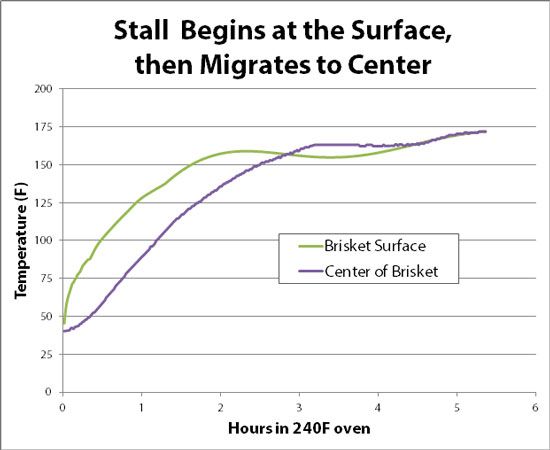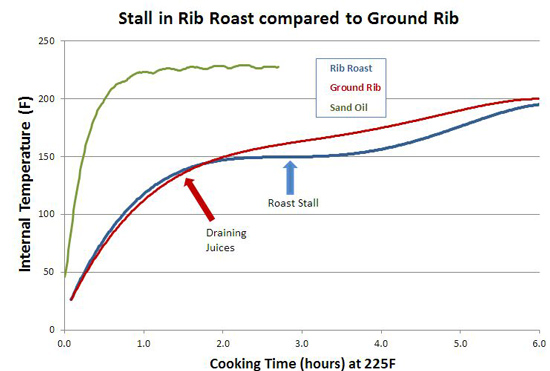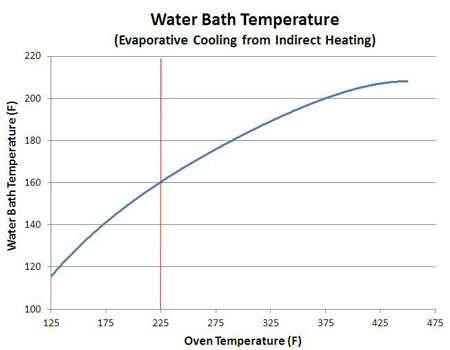What Is Brisket Stall Temp In Smoking?

The brisket stall temp in smoking refers to the phenomenon where the internal temperature of the brisket plateaus or stops rising during the smoking process. This stall typically occurs when the internal temperature reaches around 160 to 165 degrees Fahrenheit. During this time, the temperature may even drop slightly, causing concern for smoke enthusiasts. However, it is an essential part of the smoking process as it allows the connective tissues in the meat to break down, resulting in a more tender and flavorful brisket. It can last for several hours, sometimes even exceeding four hours. To achieve the desired tenderness, patience is key when dealing with the brisket stall temp.
What Causes The Brisket Stall Temp During Smoking
During smoking, the brisket stall temp occurs due to the collagen in the meat. As the internal temperature reaches around 160 to 165 degrees Fahrenheit, the collagen proteins begin to combine with moisture and convert into gelatin. This process is what gives the brisket its tenderness and juiciness. However, this conversion takes time and can cause the temperature to plateau or even drop slightly. Another contributing factor to the stall is the rendering of fat in the meat. The rendered fat can cool down the brisket, further prolonging the stall. While the stall may be frustrating for smokers, it is an essential step in achieving a delicious and tender brisket.
How To Overcome The Brisket Stall Temp
To overcome the brisket stall temp during smoking, there are a few strategies that can be employed. One option is to increase the cooking temperature. Instead of cooking at a low and slow temperature, try raising the heat to around 290-350°F. This higher temperature will help speed up the cooking process and reduce the length of the stall. Another technique is to wrap the brisket in foil or butcher paper once it reaches the stall. This wrapping helps to retain moisture and promotes faster cooking, bypassing the stall. Additionally, some pitmasters recommend spritzing the brisket with a liquid, such as apple juice or beef broth, during the stall. This moisture can help keep the surface of the meat cooler and prevent it from drying out. Overall, by adjusting the cooking temperature, using wrapping techniques, and adding moisture, smokers can effectively overcome the brisket stall temp and achieve a delicious, tender brisket.
Strategies To Overcome The Temperature Plateau While Smoking Brisket

There are several strategies that can be employed to overcome the temperature plateau while smoking brisket. One effective technique is to increase the cooking temperature. By raising the heat to around 290-350°F, the cooking process can be sped up, reducing the length of the stall. Another strategy is to wrap the brisket in foil or butcher paper once it reaches the stall. This wrapping helps to retain moisture and promotes faster cooking, bypassing the plateau. Additionally, some pitmasters recommend spritzing the brisket with a liquid, such as apple juice or beef broth, during the stall. This moisture can help keep the surface of the meat cooler and prevent it from drying out. Overall, by adjusting the cooking temperature, using wrapping techniques, and adding moisture, smokers can effectively overcome the temperature plateau and achieve a delicious, tender brisket.
Factors Affecting The Brisket Stall Temp
Understanding the different variables that can impact the temperature plateau in smoking brisket is essential for achieving a successful cook. Several factors can contribute to the stall experienced during the smoking process. The size and shape of the brisket can affect the stall temp, with larger cuts typically experiencing longer stalls. The level of marbling and fat content in the brisket can also influence the stall, as fat takes longer to render and can cause a longer plateau period. Additionally, ambient temperature and humidity levels can affect the stall temp, with cooler environments potentially prolonging the stall. The type of smoker used, such as an offset smoker or pellet grill, can also play a role in the stall. Understanding and accounting for these factors can help smokers adjust their cooking techniques and overcome the plateau to achieve delicious, tender brisket.
Understanding The Different Variables That Can Impact The Temperature Plateau In Smoking Brisket
Several factors can contribute to the stall experienced during the smoking process. The size and shape of the brisket can affect the stall temp, with larger cuts typically experiencing longer stalls. The level of marbling and fat content in the brisket can also influence the stall, as fat takes longer to render and can cause a longer plateau period. Additionally, ambient temperature and humidity levels can affect the stall temp, with cooler environments potentially prolonging the stall. The type of smoker used, such as an offset smoker or pellet grill, can also play a role in the stall. Understanding and accounting for these factors can help smokers adjust their cooking techniques and overcome the plateau to achieve delicious, tender brisket.
Importance Of Patience During The Brisket Stall Temp

During the brisket stall temp, patience plays a crucial role in achieving a perfectly cooked and tender brisket. It can be tempting to rush the cooking process or try to intervene to speed up the temperature increase. However, it is important to maintain patience and resist the urge to adjust the cooking conditions.
The stall is a natural and necessary part of the smoking process, allowing the collagen and connective tissues in the brisket to break down and become tender. Patience is key during this stage as it ensures that the meat is cooked evenly and results in a moist and flavorful final product.
Attempting to rush through the stall by increasing the heat or adjusting the cooking time can result in a tough and dry brisket. It is crucial to trust the process and allow the brisket to slowly and gradually reach its desired temperature. By exercising patience, you can achieve a truly delicious and succulent brisket that will be worth the wait.
Why Patience Is Key When Dealing With The Temperature Plateau While Smoking Brisket
During the temperature plateau, patience becomes a crucial virtue for achieving a perfectly cooked brisket. It is tempting to try to intervene and speed up the cooking process when the temperature stalls. However, it is important to understand that the stall is a natural and necessary phase in the smoking process. It allows the collagen and connective tissues in the brisket to break down, resulting in a moist and tender final product.
Rushing through the stall by increasing the heat or adjusting the cooking time can lead to a tough and dry brisket. Instead, it is essential to trust the process and give the brisket the time it needs to gradually reach its desired temperature. By exercising patience, you allow the flavors to develop and the meat to become tender and flavorful.
Remember, great things come to those who wait, and in the case of smoking a brisket, patience is truly the key to success.
Tips And Tricks For Handling The Brisket Stall Temp
When facing the brisket stall temp during smoking, there are a few tips and tricks that can help navigate through this phase successfully.
- Wrap the brisket: One effective method to power through the stall is to wrap the brisket in foil or butcher paper. This can help to push through the plateau faster and retain moisture in the meat.
- Increase the heat: If you’re pressed for time, you can slightly increase the temperature of your smoker to help accelerate the cooking process. However, be careful not to raise the heat too much, as it can result in a dry brisket.
- Patience is key: While it may be tempting to intervene and try to speed up the cooking process, it’s important to remember that patience is key. Trust the process and allow the brisket to slowly reach its desired temperature for the best results.
- Use a water pan: Placing a water pan in your smoker can help keep the environment moist, preventing the brisket from drying out during the stall.
- Consider the Texas crutch: The Texas crutch technique involves wrapping the brisket in foil or butcher paper while it’s in the stall. This method can help to power through the plateau more quickly.
By employing these tips and tricks, you can handle the brisket stall temp with confidence and achieve a perfectly cooked, tender brisket.
Useful Tips And Tricks To Navigate Through The Temperature Plateau When Smoking Brisket

Navigating through the temperature plateau when smoking brisket can be a challenge, but there are useful tips and tricks that can help. One effective method is to wrap the brisket in foil or butcher paper, which can push through the plateau faster and retain moisture in the meat. Increasing the heat slightly can also help accelerate the cooking process, but be cautious not to raise it too much and risk drying out the brisket. Patience is key during the stall, so resist the temptation to intervene and allow the brisket to slowly reach its desired temperature. Using a water pan in the smoker can help keep the environment moist and prevent the meat from drying out. Another technique to consider is the Texas crutch, which involves wrapping the brisket in foil or butcher paper to power through the plateau more quickly. By applying these tips and tricks, you can handle the brisket stall temp with confidence and achieve a perfectly cooked, tender brisket.
Conclusion
In conclusion, understanding the brisket stall temp is crucial for achieving a perfectly cooked brisket in smoking. The temperature plateau is a natural occurrence during the cooking process, where the internal temperature of the brisket plateaus for several hours. This phenomenon can be attributed to the collagen in the meat breaking down slowly. Patience is key during this stage, as rushing the process can result in a tough and dry brisket. However, there are strategies to overcome the stall, such as wrapping the brisket in foil or butcher paper, increasing the heat slightly, and using a water pan to maintain moisture. By navigating through the temperature plateau with these tips and tricks, one can achieve tender and flavorful brisket that will impress any barbecue enthusiast.
Summary Of Key Points About The Brisket Stall Temp And Its Significance In Smoking Brisket
The Brisket Stall Temp, a phenomenon that occurs during the smoking process, is when the internal temperature of the brisket plateaus for several hours. This stall typically happens around 160 to 165 degrees Fahrenheit. It is caused by the collagen in the meat breaking down slowly, resulting in a temporary halt in temperature increase. Understanding this temperature plateau is crucial for achieving a perfectly cooked brisket. Patience is key during this stage, as rushing the process can lead to a tough and dry brisket. To overcome the stall, strategies such as wrapping the brisket, increasing the heat slightly, and using a water pan to maintain moisture can be employed. By navigating through the temperature plateau, one can achieve a tender and flavorful brisket that will impress barbecue enthusiasts.
FAQ About Brisket Stall Temp: Understanding Temperature Plateaus In Smoking
Q: What is the brisket stall temp phenomenon in smoking?
A: The brisket stall temp is a phase during smoking where the internal temperature of the brisket plateaus, leading to a temporary halt in temperature rise.
Q: Why does the brisket stall temp occur?
A: The stall temp occurs as the collagen in the meat begins to break down, causing evaporative cooling that balances out the temperature increase.
Q: How long does the brisket stall temp last?
A: The stall temp can last for several hours, during which the internal temperature of the brisket may not increase significantly.
Q: Should I be concerned if my brisket stalls during smoking?
A: No, the stall temp is a normal part of the smoking process and is actually a sign that the collagen in the brisket is beginning to tenderize.
Q: How can I overcome the brisket stall temp?
A: You can wrap the brisket in foil or butcher paper during the stall to help push through the plateau and continue the temperature rise.
Q: Can I speed up the brisket stall temp phase?
A: While some techniques can accelerate the process, it is generally recommended to let the brisket stall naturally for the best results in terms of tenderness and flavor.
Q: Does the brisket stall temp affect the final outcome of the smoked brisket?
A: Yes, the brisket stall temp is a crucial phase that contributes to the tenderness and juiciness of the final smoked brisket, so it should be embraced rather than rushed.

Stutts House of Barbecue is a haven for BBQ enthusiasts, offering a delectable array of smoked delicacies, including ribs, beef, bologna, and chicken, accompanied by all the trimmings you could ever dream of. Our passion for perfecting the art of smoking meats shines through in every savoury bite. At Stutts House of Barbecue, we take pride in our custom smoking techniques, ensuring that each piece of meat is infused with the perfect blend of smoky flavours. But it doesn’t stop there – our homemade desserts are the cherry on top of a delicious meal, adding a sweet finish to your BBQ experience.